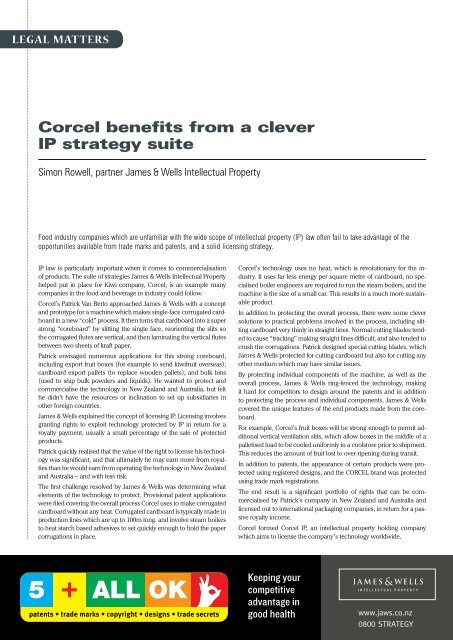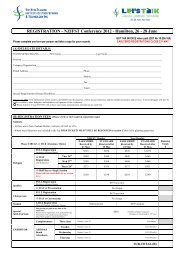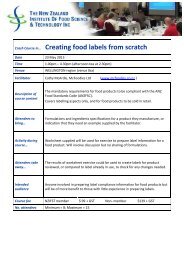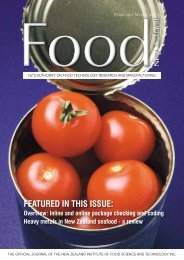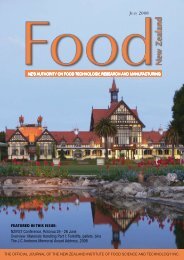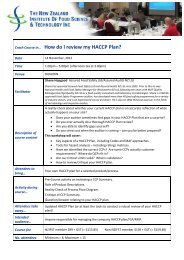FEATURED IN THIS ISSUE: - NZIFST - The New Zealand Institute of ...
FEATURED IN THIS ISSUE: - NZIFST - The New Zealand Institute of ...
FEATURED IN THIS ISSUE: - NZIFST - The New Zealand Institute of ...
Create successful ePaper yourself
Turn your PDF publications into a flip-book with our unique Google optimized e-Paper software.
Legal mattersCorcel benefits from a cleverIP strategy suiteSimon Rowell, partner James & Wells Intellectual PropertyFood industry companies which are unfamiliar with the wide scope <strong>of</strong> intellectual property (IP) law <strong>of</strong>ten fail to take advantage <strong>of</strong> theopportunities available from trade marks and patents, and a solid licensing strategy.IP law is particularly important when it comes to commercialisation<strong>of</strong> products. <strong>The</strong> suite <strong>of</strong> strategies James & Wells Intellectual Propertyhelped put in place for Kiwi company, Corcel, is an example manycompanies in the food and beverage in industry could follow.Corcel’s Patrick Van Berlo approached James & Wells with a conceptand prototype for a machine which makes single-face corrugated cardboardin a new “cold” process. It then turns that cardboard into a superstrong “coreboard” by slitting the single face, reorienting the slits sothe corrugated flutes are vertical, and then laminating the vertical flutesbetween two sheets <strong>of</strong> kraft paper.Patrick envisaged numerous applications for this strong coreboard,including export fruit boxes (for example to send kiwifruit overseas),cardboard export pallets (to replace wooden pallets), and bulk bins(used to ship bulk powders and liquids). He wanted to protect andcommercialise the technology in <strong>New</strong> <strong>Zealand</strong> and Australia, but felthe didn’t have the resources or inclination to set up subsidiaries inother foreign countries.James & Wells explained the concept <strong>of</strong> licensing IP. Licensing involvesgranting rights to exploit technology protected by IP in return for aroyalty payment, usually a small percentage <strong>of</strong> the sale <strong>of</strong> protectedproducts.Patrick quickly realised that the value <strong>of</strong> the right to license his technologywas significant, and that ultimately he may earn more from royaltiesthan he would earn from operating the technology in <strong>New</strong> <strong>Zealand</strong>and Australia – and with less risk.<strong>The</strong> first challenge resolved by James & Wells was determining whatelements <strong>of</strong> the technology to protect. Provisional patent applicationswere filed covering the overall process Corcel uses to make corrugatedcardboard without any heat. Corrugated cardboard is typically made inproduction lines which are up to 100m long, and involve steam boilersto heat starch based adhesives to set quickly enough to hold the papercorrugations in place.FA 15563 JAWS Food Mag Ad pth.pdf 1 21/09/11 4:48 PMCorcel’s technology uses no heat, which is revolutionary for the industry.It uses far less energy per square metre <strong>of</strong> cardboard, no specialisedboiler engineers are required to run the steam boilers, and themachine is the size <strong>of</strong> a small car. This results in a much more sustainableproduct.In addition to protecting the overall process, there were some cleversolutions to practical problems involved in the process, including slittingcardboard very thinly in straight lines. Normal cutting blades tendedto cause “tracking” making straight lines difficult, and also tended tocrush the corrugations. Patrick designed special cutting blades, whichJames & Wells protected for cutting cardboard but also for cutting anyother medium which may have similar issues.By protecting individual components <strong>of</strong> the machine, as well as theoverall process, James & Wells ring-fenced the technology, makingit hard for competitors to design around the patents and in additionto protecting the process and individual components, James & Wellscovered the unique features <strong>of</strong> the end products made from the coreboard.For example, Corcel’s fruit boxes will be strong enough to permit additionalvertical ventilation slits, which allow boxes in the middle <strong>of</strong> apalletised load to be cooled uniformly in a coolstore prior to shipment.This reduces the amount <strong>of</strong> fruit lost to over-ripening during transit.In addition to patents, the appearance <strong>of</strong> certain products were protectedusing registered designs, and the CORCEL brand was protectedusing trade mark registrations.<strong>The</strong> end result is a significant portfolio <strong>of</strong> rights that can be commercialisedby Patrick’s company in <strong>New</strong> <strong>Zealand</strong> and Australia andlicensed out to international packaging companies, in return for a passiveroyalty income.Corcel formed Corcel IP, an intellectual property holding companywhich aims to license the company’s technology worldwide.28Food <strong>New</strong> <strong>Zealand</strong>


